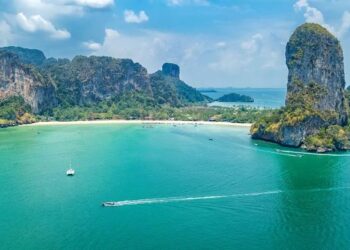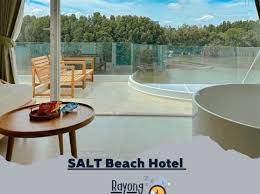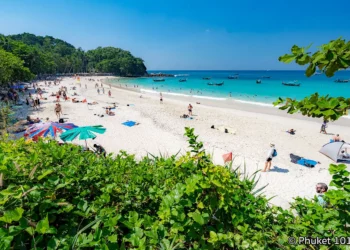Varkala Beach is on Kerala’s southern coast, in the Thiruvananthapuram district. It runs for about 6 km, with soft golden sands and striking red cliffs known as the Varkala Formation, protected as a geological monument. The gentle waters, spiritual sites, and wellness centres draw tourists from across India and other countries.Local tourism groups look after the area.
Fun Fact About Varkala Beach
Varkala Beach is unique in southern Kerala because its cliffs meet the Arabian Sea directly, a rare feature that got it listed among the world’s top 10 seasonal beaches by the Discovery Channel. The red cliffs, made of tertiary sedimentary rock, have natural water springs and spouts, which locals believe have healing properties.
History of Varkala Beach
Varkala Beach is known for its mix of nature and spirituality. The red cliffs, made from really old sedimentary rocks from the Tertiary period, were slowly formed by the sea over many years. Humans have lived around this area for thousands of years, and the name “Varkala” comes from Sanskrit, meaning something connected to spiritual cleansing.
One of the oldest landmarks is the Janardhana Swamy Temple on the cliffs, more than 2,000 years old and dedicated to Lord Vishnu. Pilgrims visit because the beach waters are thought to wash away sins, giving it the name Papanasam Beach, meaning “sin-destroying.” Local stories say a saint meditated here in the 9th century, making Varkala an important pilgrimage site.
European influence began in the 17th century when the British East India Company built Anjengo Fort nearby in 1696 for trade. This brought quite a few colonial architecture and connected Varkala to trade routes. In the 19th and 20th centuries, it became a quiet retreat for Kerala’s rich and wealthy, however it stayed mostly low-key until the late 1900s.
After India’s independence, Varkala grew as a wellness spot with Ayurveda and yoga. The Sivagiri Mutt, set up in 1904 by Sree Narayana Guru, added to its spiritual fame and hosts yearly pilgrimages.
Things to Do at Varkala Beach
Varkala Beach gives quite a mix of relaxing and active things to do, all with the cliffs and sea as a backdrop.
Cliff Walks and Sunsets: Walk along the North Cliff path where there are small cafes and shops. The views of the Arabian Sea are great, especially at sunset when the sky turns orange and the sun sinks into the sea.
Swimming and Beach Time: The wide sandy beach is quite good for sunbathing or paddling in the shallow water. Lifeguards often watch packed areas in busy seasons, but still watch out for any occasional strong currents.
Water Sports: You can try surfing, parasailing, kayaking, jet skiing, or banana boat rides. The waves there are steady, making Varkala one of the top surfing spots in India.
Yoga and Ayurveda: There are more than 30 centers offering yoga, wellness sessions and treatments using the local mineral springs. Doing yoga on the cliffs with the sea breeze is very refreshing.
Cultural Spots: The Janardhana Swamy Temple has beautiful Dravidian architecture, and its Arattu festival is popular. The Sivagiri Mutt shows Kerala’s social reform history, and the Varkala Tunnel, built in the 19th century, tells a story of old hydraulic engineering.
Nearby Trips: Kappil Beach and Lake, 7 km north, is great for boating among mangroves. Anjengo Fort, about 25 km away, has old colonial ruins and a lighthouse.
Food and Shopping: Eat local Kerala dishes like seafood curry, appams, or sadhya thalis at cliffside restaurants. There are also markets for handicrafts, spices, and jewelry.
Best Time to Visit Varkala Beach
October to December
After the monsoon, the weather cools down (around 25°C–32°C), skies are mostly clear, and the cliffs and greenery look fresh. Crowds are smaller, so cliff walks feel peaceful. Early rains can still happen. Festivals like Dussehra bring local culture alive.
January to March
This dry season is sunny (28°C–35°C), perfect for beach lounging and water sports. Visitor numbers are moderate, so it’s easier to enjoy wellness activities and mineral springs.
April to May
It gets hotter (30°C–38°C) and humid before the monsoon. Early mornings are best for yoga or visiting temples. Crowds are thinner, but afternoon showers are common. Staying hydrated is important.
June to September
Monsoon season brings heavy rain (25°C–30°C) and rough seas, so swimming may be limited. The rains make backwaters look beautiful, and accommodation rates are lower. It’s a good time for indoor activities like Ayurvedic treatments.
Travel Tips
Check Currents and Tides: Swimming areas are marked, but rip currents exist. Listen to lifeguards and avoid going alone into the sea. Also, check local forecasts for your safety.
Take Care of Nature: The cliffs are quite delicate, so it is always best to follow the marked paths. Also, do bring refillable bottles and if you can, do buy from shops that care about the environment.
Sun Tips: Sunlight can be strong even in winter. Put on strong sunscreen (SPF 50+), wear a hat, and try to do things in the morning or evening. Keep water or electrolyte drinks with you.
Getting Around: Most autos and taxis don’t have meters. Always agree on the price before you go, maybe around ₹100 for short trips. Using apps like Ola can make fares easier and fixed.











